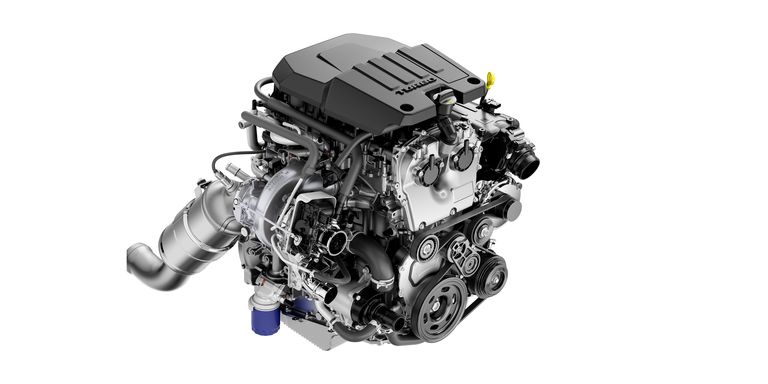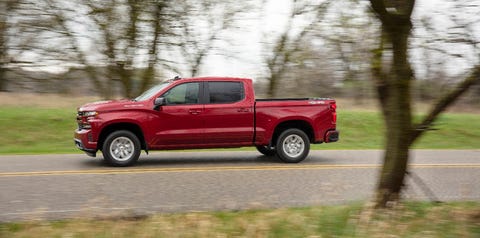Moving More With Less: Why Four-Cylinders Are Coming to Full-Size Trucks
The 2019 models of the GMC Sierra and Chevy Silverado feature four-bangers, the first time such a small engine has powered such a big truck. We explain the engineering that made it possible.
 GM
GMGeneral Motors is making a big move into small engines.
The Chevy Silverado 1500 and GMC Sierra 1500 get an all-new powerplant option for 2019: a 2.7-liter turbocharged inline-four. Designed from the engine block up to be a truck motor full of low-end torque, the “2.7L” will be the first four-cylinder in a full-size pickup.
Four-bangers have come a long way in the past few years as tighter emissions regulations and rising fuel costs have pushed automakers to replace thirstier V6s and V8s. The new four-cylinder for the Sierra and Silverado is more proof that engine tech once seen as exotic and experimental is now ready for the big boys.
Four Is the Magic Number

2019 Chevy Silverado
GM
GM’s 2.7-liter engine pushes out 310 horsepower, and all 348 ft-lbs. of its torque are available between 1,500 and 4,000 RPM, the low range where trucks hauling a load need power the most. Those were V8 numbers just five years ago. The 5.3L V8 Vortec 5300 that powered most of GM's full-size trucks, SUVs, and vans through 2013 and 2014 put out about 315 hp and 330-340 ft-lbs. of torque depending on how you used it.
The 2.7L is also light. It undercuts the V6 by 380 pounds, even though both engines have aluminum blocks and cylinder heads.
“There are many considerations that go into deciding 'why a four?',” says Craig Marriott, GM's assistant chief engineer on the 2.7L project. “However, significant considerations are lower friction, heat loss, and mass, which translates to improved efficiency and handling.”
The 2.7L is the first GM engine to use cylinder deactivation on a four-cylinder engine. Under light loads, the engine shuts down two cylinders to conserve fuel. There's also a gas-saving start/stop system that shuts off the engine when the truck stops and restarts it when the driver lifts their foot off the brake pedal (it can be disabled if the driver wants to keep the engine running).
The Turbocharged Truck
Turbochargers have been the auto industry’s secret weapon as it attempts to move toward smaller, more efficient engines without sacrificing power. So far we’ve yet to see many turbos in gas-powered pickups, but clearly that’s about to change.
Turbochargers work by redirecting exhaust gas as it leaves the engine's exhaust manifold, funneling it into a chamber (call the volute) that uses that exhaust gas to spin a turbine. That turbine spins an air pump that feeds extra air into the engine to make more power.
“THERE ARE MANY CONSIDERATIONS THAT GO INTO DECIDING 'WHY A FOUR?'”
Most single-turbo designs use one volute. The new 2.7L, while technically a single-turbo engine, uses two volutes by integrating the exhaust manifold (which is typically separate) with the turbocharger housing into one unit. Using two volutes reduces turbo lag, the delay between pressing the accelerator and when the turbo kicks in, and improves low-RPM torque. The inherent complication with this design is that exhaust gases are hot, and hot air packs less power than denser cold air. So, before sending air into the engine, the turbo pumps the hot air through a charge-air cooler that lowers its temperature 130 degrees Fahrenheit.
Even with the charge-air cooler, however, turbo engines generate a lot of heat under the hood. Typical engine cooling systems work by chilling coolant via airflow in the radiator, passing it through hoses to the engine block to absorb and dissipate engine heat, and then back through hoses to the radiator to be cooled again. Normal systems can't direct coolant to specific parts of the engine—it just runs in a loop.
The 2.7L is GM's first engine to use Active Thermal Management, in which the on-board computer can target the flow of coolant to specific parts of the engine. If, say, you're towing a heavy load and part of the engine is running hot, the system will target coolant to that area to bring down the temperature. If you get into a cold truck that sat overnight and then flick on the heater, the engine will hold back coolant from the part of the engine responsible for heating the air that blows through interior vents. You'll get a warm cabin sooner.
Pickup Nation

2019 Chevy Silverado
GM
Four-bangers aren’t taking over the truck market right away. Although it will come standard on the mid-range LT and RST trim levels, the 2.7L won't be an option on lower trim levels. The WT, Custom, and Custom Trail Boss versions of GM trucks will stick with the carryover 4.3-liter EcoTec V6, which won't change much from the old version. GM expects 80 percent of Silverado and Sierra sales to be V8s, with 10 percent going for the V6 and 10 percent going for the four-cylinder, Marriott says.
Pickup trucks are an extremely profitable segment of the market, and companies sell 2.8 million new ones a year in the U.S. alone. Buyers aren't going to give them up even as fuel prices inevitably crawl high, and companies aren't going to compromise them even as environmental legislation demands cleaner, more fuel efficient ways to move three tons down the highway at 80 miles per hour.
Looking at the 2.7L’s clean-sheet design (which is not cheap) it's a safe bet GM is committed to downsizing motors, following a trend Ford started in full-size pickups when it released the 2.7L twin-turbo EcoBoost V6 in the 2015 F-150. What's new is that automakers are using not exotics and luxury model, but relying on bread-and-butter pickup trucks to introduce new technologies such as GM's four-cylinder deactivation, dual-volute turbo, and Active Thermal Management.
As long as Americans keep buoying the pickup market, expect it to become a trend.
No comments:
Post a Comment